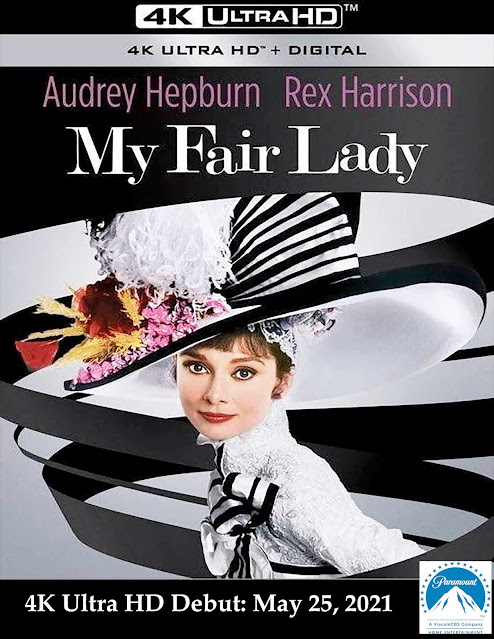Paramount Home Entertainment announced this past week that a new 4K Ultra HD presentation of director George Cukor’s 1964 Best Picture-winner, My Fair Lady, will be available on May 25 as a double-disc set.
Back in 1913, just prior to The Great War (later to be known as World War I), George Bernard Shaw delivered the stage play, Pygmalion, drawn from Greek myth about the thus-named sculptor who falls in love with his creation. The great irony in Shaw’s initial production was that it did not have a “happy ending” … which was taken care of during the 1914 London run, when the producer “tinkered” with Shaw’s play to achieved the audience-pleasing “happy ending,” which, of course, did not please the playwright.
Five film productions and numerous revivals of the play followed and in March of 1956 it returned to Broadway, this time as a Lerner and Loewe musical adaptation of Shaw’s play and titled My Fair Lady, with Rex Harrison as Henry Higgins and a newcomer by the name of Julie Andrews as Eliza Doolittle.
Despite winning the Tony Award for Best Musical, it wasn’t until 1961 that the trade press became alerted to the news about a possible film production.
Julie Andrews did not have a track record in film, indeed it wasn’t until her starring performance in Mary Poppins in 1964 that she even appeared in a theatrical release — strictly a 20-something stage performer with a marvelous singing voice. In what would prove to be cinema-irony, she would win the Best Actress Oscar in her film debut.
By the time the film went into production, the Broadway musical version had run for six years and over 2,700 performances, with Julie Andrews becoming a star during the period … and was acclaimed for her Eliza Doolittle portrayal. She would not be among those considered for the film role. Instead, the first cast member named to the production — which wouldn’t actually begin for a full year (and more) — was Audrey Hepburn, an established screen star with four Oscar nominations for Best Actress, winning for Roman Holiday (1954). Her other Oscar nominations were for Breakfast at Tiffany’s (1962), The Nun Story (1960) and Sabrina (1954).
In short, Hepburn was “bankable” … Andrews was not.
Casting, oh my, when you have a bid-budget Hollywood film production in the works, the trade press becomes filled with rumors. Peter O’Toole, Richard Burton and Cary Grant were among those mentioned, but when it came down to finally making the decision of who would play Henry Higgins, Rex Harrison won easily … so did Stanley Holloway (a London stage actor with a long film career as a character actor) as Eliza’s father, Alfred.
Despite being very “English” in its nature, My Fair Lady, was filmed on sound stages in Burbank, California — second unit “establishing” shots were filmed in and around London. Two months of rehearsals — much like a stage play — took place before the filming actually began … and once the filming did commence, it went from the summer of 1963 well into the fall of that year.
Another trick of “Hollywood,” or should we say “magic” of studio productions, is that Audrey Hepburn’s singing voice was rejected in favor of Marni Nixon, who had previously doubled for Natalie Wood in West Side Story and earlier for Deborah Kerr in The King and I.
The result was a smash theatrical hit, which won Oscars for Best Picture, Best Actor, Best Director (Cukor’s only win after being previously nominated for Born Yesterday, A Double Life, The Philadelphia Story and Little Women) and swept most of the technical awards as well.
As to bonus goodies for the 4K Ultra HD double-disc release from Paramount Home Entertainment on May 25, it comes absolutely loaded with materials that were previously gathered together for the Blu-ray presentation celebrating the 50th Anniversary of the film’s release back in 2014.





No comments:
Post a Comment